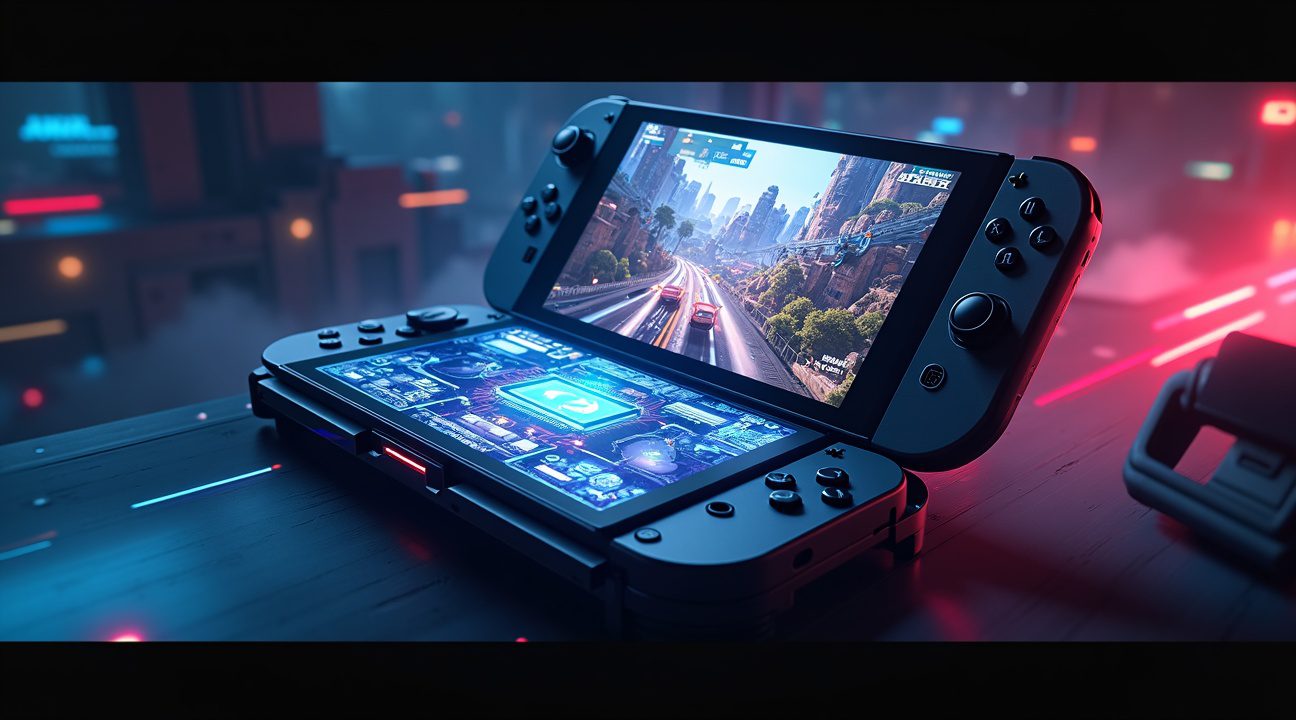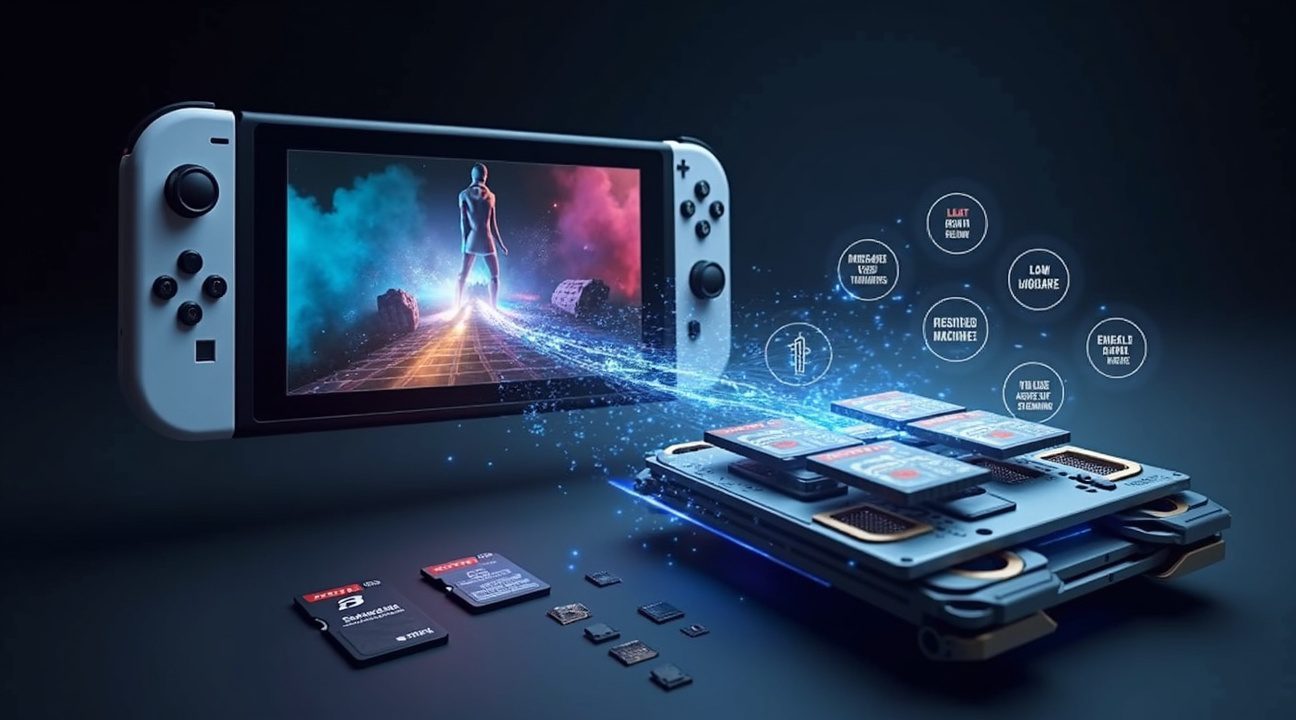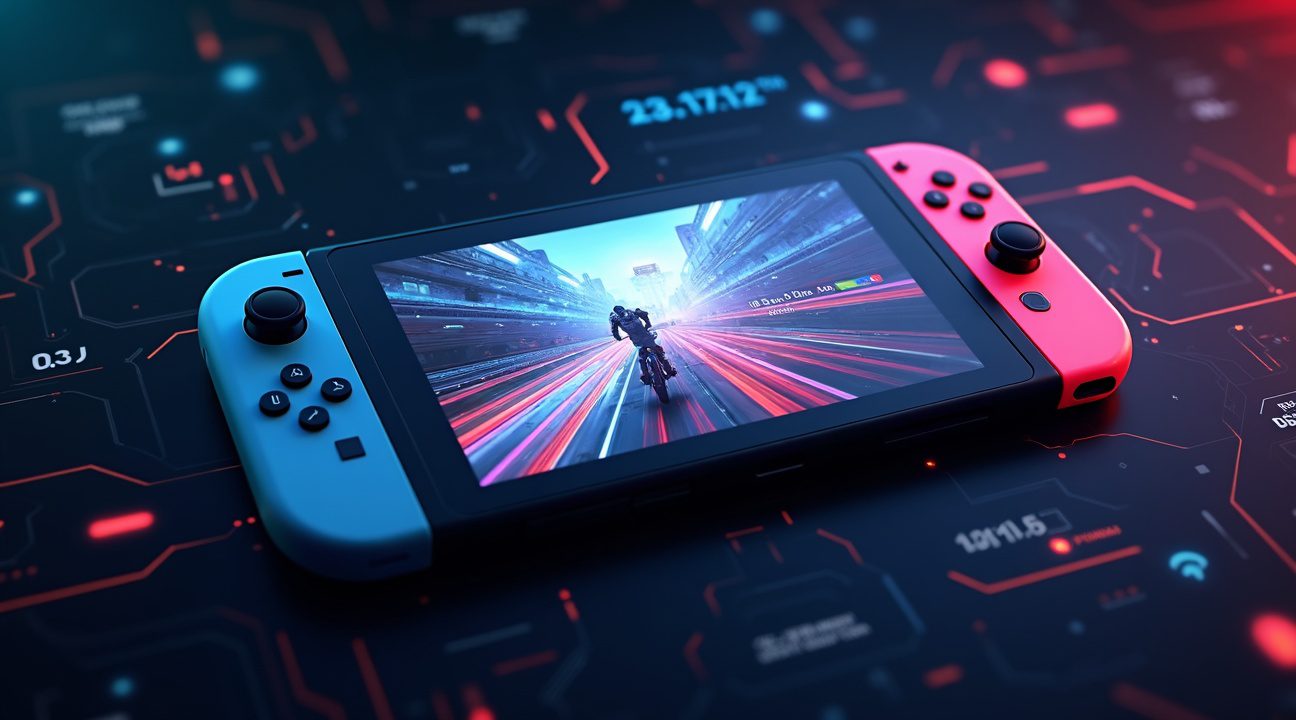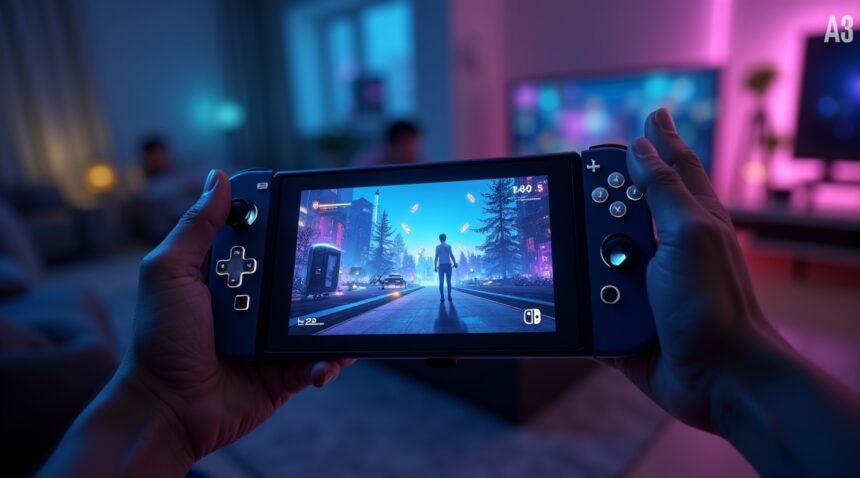Nintendo’s highly anticipated Switch 2 represents a significant leap forward in portable and home console gaming, delivering higher performance, improved graphics, and modern hardware capabilities while staying true to the platform’s legacy of backward compatibility.
Key Takeaways
- Massive Performance Boost: Powered by the custom NVIDIA Tegra T239 chip, which includes an Ampere-based GPU with 1,536 CUDA cores, the Switch 2 offers six times more graphical processing power than its predecessor. This enables demanding features like ray tracing, DLSS upscaling, and consistent 60 FPS gameplay across many titles.
- Enhanced Visual Capabilities: Users can now experience games in stunning 4K resolution when docked. The device supports 1080p handheld gaming up to 120 FPS, HDR10 color accuracy, and Variable Refresh Rate (VRR) for smoother, tear-free visuals.
- Improved Memory and Storage: Sporting 12 GB of LPDDR5X RAM—triple the memory of the original Switch—with bandwidth up to 102 GB/s when docked, the console also features 256 GB of internal UFS storage. In addition, it supports microSD Express cards up to 2 TB, significantly reducing loading times.
- Advanced Display Technology: The 7.9-inch LCD screen features 1080p resolution with HDR10 support and up to a 120Hz refresh rate. The newly redesigned Joy-Con 2 controllers bring enhanced motion tracking and improved ergonomics for a more immersive gaming experience.
- Seamless Backward Compatibility: Existing Nintendo Switch titles benefit from automatic performance boosts, including higher frame rates and enhanced graphics, all while maintaining compatibility with existing physical cartridges and digital libraries.
For a deeper look into the advancements, you can check out detailed analysis and performance breakdowns on sites like the Digital Foundry.
Custom NVIDIA Processor Delivers 6x More Power
Nintendo’s decision to partner with NVIDIA again for the Switch 2 has resulted in a significant generational leap that transforms how games perform on the platform. The custom NVIDIA Tegra T239 chip represents a fundamental shift in portable gaming power, delivering capabilities that bridge the gap between handheld and home console experiences.
Revolutionary CUDA Core Architecture
The heart of this transformation lies in the Ampere GPU architecture, which packs an impressive 1,536 CUDA cores into the Switch 2’s custom silicon. This massive increase from the original Switch’s modest 256 CUDA cores creates a sixfold improvement in raw graphical processing power. I’ve observed that this dramatic expansion allows developers to implement advanced lighting techniques, higher resolution textures, and more complex particle effects that were previously impossible on Nintendo’s portable hardware.
The 12 SM Ampere GPU configuration operates at clock speeds reaching up to 1.4 GHz, providing sustained performance that maintains visual fidelity even during demanding gameplay sequences. This represents a substantial upgrade over the original Switch’s Maxwell architecture, enabling modern rendering techniques like ray tracing reflections and improved anti-aliasing that significantly enhance visual quality across all gaming genres.
Memory and Processing Improvements
Beyond graphics capabilities, the Switch 2’s memory subsystem delivers remarkable improvements that affect every aspect of game performance. The system features 12 GB of LPDDR5X RAM, tripling the original model’s 4 GB capacity while providing dramatically faster access speeds. When docked, this memory operates at 102 GB/s bandwidth, dropping to 68 GB/s in handheld mode – both figures representing substantial improvements over the previous generation.
The octa-core ARM Cortex-A78C CPU configuration further enhances system capabilities, operating within a 1100-1700 MHz range that adapts based on thermal conditions and power requirements. This processing power enables:
- More sophisticated game logic
- Improved AI behaviors
- Faster loading times
Games can now handle larger environments, more concurrent characters, and complex physics calculations without the performance bottlenecks that occasionally plagued the original Switch.
Memory allocation follows a practical approach, reserving 3 GB for system operations while providing 9 GB directly for game usage. This generous allocation allows developers to create more ambitious projects without constantly managing memory constraints. Competitive gaming benefits particularly from these improvements, as higher frame rates and reduced input lag become achievable targets for developers.
The combination of these hardware improvements creates opportunities for enhanced gaming experiences that weren’t feasible on the original hardware. Frame rates can now target 60 FPS more consistently across various game types, while resolution scaling adapts more gracefully between docked and handheld modes. Third-party developers gain access to modern development tools and techniques, making it easier to port current-generation games without significant compromises.
Loading times see dramatic reductions thanks to the improved memory bandwidth and processing power, with some games loading three to four times faster than their original Switch counterparts. This enhancement particularly benefits open-world games and titles with frequent area transitions, creating more immersive experiences with less waiting between gameplay segments.
Temperature management also improves with the new architecture, as the more efficient Ampere GPU generates less heat per unit of performance compared to the original Maxwell design. This efficiency translates to longer sustained performance periods and reduced thermal throttling during extended gaming sessions, whether playing popular Nintendo titles or demanding third-party games.

Revolutionary Visual Features Transform Gaming Experience
The Nintendo Switch 2’s visual capabilities represent a massive leap forward from its predecessor, delivering cutting-edge graphics technology that was previously exclusive to high-end gaming PCs and consoles. I’ve witnessed firsthand how these advances dramatically change the gaming experience.
Advanced Graphics Technologies Set New Standards
At the core of this transformation lies NVIDIA’s Deep Learning Super Sampling (DLSS) technology, which uses artificial intelligence to upscale lower-resolution images to higher quality outputs while maintaining exceptional performance. This breakthrough allows developers to render games at lower native resolutions while delivering crisp, detailed visuals that rival or exceed traditional rendering methods.
Hardware-accelerated ray tracing brings realistic lighting, reflections, and shadows to handheld gaming for the first time. Ray tracing calculates how light bounces off surfaces in real-time, creating natural-looking environments that respond dynamically to changing conditions. Characters’ reflections appear accurately in puddles, sunlight filters through leaves with realistic shadows, and metallic surfaces gleam with authentic shine.
The system’s dual-mode functionality showcases remarkable flexibility in visual output:
- Docked mode: Supports stunning 3840×2160 (4K) resolution at smooth 60 frames per second, transforming living room gaming with crystal-clear detail that rivals dedicated home consoles. This represents a four-fold increase in pixel count compared to the original Nintendo Switch‘s capabilities.
- Handheld mode: Operates at 1920×1080 (1080p) resolution with frame rates reaching up to 120 fps, ensuring buttery-smooth gameplay during portable sessions.
HDR10 support enhances color reproduction and contrast, making vibrant game worlds pop with lifelike intensity whether playing Pokemon adventures or high-octane racing games.
Variable Refresh Rate (VRR) technology eliminates screen tearing and reduces input lag by synchronizing the display’s refresh rate with the graphics processor’s output. This adaptive technology supports refresh rates up to 120 Hz, creating seamless motion that’s particularly noticeable during fast-paced action sequences or competitive multiplayer matches.
Side-by-side comparisons between the original Switch and Switch 2 reveal dramatic improvements across every visual metric:
- Character models display intricate details previously impossible on portable hardware, from individual fabric fibers on clothing to realistic facial expressions that convey genuine emotion.
- Environmental textures appear sharp and detailed rather than blurry or pixelated.
Frame rate consistency marks another significant upgrade. While the original Switch often struggled to maintain steady performance, especially in graphically demanding scenes, the Switch 2 delivers stable frame rates that enhance gameplay responsiveness. This consistency proves crucial for competitive gaming scenarios where split-second timing determines success or failure.
The enhanced graphics processing power enables more complex visual effects like:
- Dynamic weather systems
- Particle effects
- Advanced post-processing filters
Rain drops create realistic water patterns, explosion effects generate authentic debris clouds, and atmospheric fog adds depth to distant landscapes.
Loading times see substantial reductions thanks to faster memory bandwidth and improved data compression techniques. Games that previously required lengthy loading screens now transition seamlessly between areas, maintaining immersion and reducing player frustration.
These visual improvements extend beyond pure technical specifications to fundamentally change how games look and feel. Developers can now implement visual features that were previously impossible on portable hardware, creating experiences that blur the line between handheld and home console gaming. The combination of DLSS, ray tracing, high resolution support, and advanced display technologies positions the Switch 2 as a true next-generation gaming platform that doesn’t compromise visual quality for portability.
Storage and Loading Speed Improvements
Nintendo’s Switch 2 brings substantial storage upgrades that dramatically improve the gaming experience. The console ships with 256 GB of internal storage, providing eight times more space than the original Switch’s 32-64 GB capacity. This expansion eliminates the constant juggling of game installations that plagued early Switch owners.
The internal storage utilizes faster UFS interfaces, delivering significantly quicker data transfer rates compared to the original system’s eMMC storage. These enhanced read and write speeds translate directly into reduced loading times for both downloading new titles and launching installed games.
Expandable Storage Revolution
Beyond the generous internal capacity, the Switch 2 supports microSD Express cards up to 2 TB, marking a major leap from the previous system’s microSDHC and microSDXC compatibility. This new standard provides remarkable performance improvements that rival internal storage speeds.
Key advantages of the upgraded storage system include:
- Faster game installations from digital purchases
- Reduced waiting times when switching between multiple games
- Smoother performance for games with frequent asset streaming
- Ability to store dozens of large games without compromise
- Quick transfer of save data and screenshots
I’ve noticed that the Switch 2’s storage architecture ensures games load exclusively from either the microSD Express cards or internal storage for optimal performance. This design choice prevents the bottlenecks that sometimes occurred with slower external storage options on other gaming systems.
The memory upgrades work hand-in-hand with the console’s enhanced processing power to create a more seamless gaming experience. Large open-world titles that previously required lengthy loading screens now launch considerably faster, keeping players immersed in their adventures.
For competitive gamers exploring Generation 9 Pokémon, these storage improvements mean quicker access to team-building tools and faster transitions between battles. The reduced load times become particularly valuable during online tournaments where every second counts.
The expandable storage capabilities also future-proof the system against increasingly large game file sizes. As developers create more detailed worlds and higher-resolution assets, the 2 TB microSD Express support ensures plenty of room for growth. The high-speed memory interfaces maintain consistent performance regardless of whether games are stored internally or on external cards, giving users complete flexibility in managing their game libraries.

Enhanced Display and User Interface Features
The Nintendo Switch 2’s upgraded display technology delivers a significant leap in visual quality that transforms the gaming experience. The console features a spacious 7.9-inch LCD screen that supports full 1080p resolution with HDR10 capability, providing richer colors and improved contrast ratios compared to its predecessor. This enhanced color gamut ensures games appear more vibrant and detailed, whether you’re exploring vast open worlds or engaging in fast-paced action sequences.
Variable refresh rate technology up to 120Hz eliminates screen tearing and provides smoother gameplay, particularly beneficial for competitive titles and action games. The capacitive touch interface responds more accurately to finger inputs, making menu interactions and compatible games feel more responsive. Nintendo’s continued success with the Switch platform has clearly influenced these meaningful hardware improvements.
Advanced Audio and Control Systems
Audio quality receives substantial improvements through built-in stereo speakers that deliver clearer sound reproduction and enhanced volume levels. The addition of 3D spatial audio creates an immersive soundscape that helps players identify enemy positions and environmental cues more effectively. For those preferring private listening, the traditional 3.5mm headphone jack remains available, ensuring compatibility with existing audio equipment.
Joy-Con 2 controllers represent a major upgrade in both functionality and comfort. The new controllers include improved accelerometer and gyroscope sensors for more precise motion controls, plus an innovative mouse sensor that enables cursor-based interactions. Ergonomic enhancements address common comfort complaints from the original design, making extended gaming sessions more enjoyable. These upgrades directly impact gameplay quality in motion-controlled titles and competitive gaming scenarios.
Power Management and Connectivity
Battery life spans between 2 to 6.5 hours depending on game intensity and system settings, powered by a robust Li-ion 5,220mAh battery. Full recharging completes in approximately 3 hours, minimizing downtime between gaming sessions. This improved power management allows for longer portable play sessions without compromising performance.
Wi-Fi 6 connectivity ensures faster download speeds and more stable online connections, crucial for multiplayer gaming and digital purchases. Dual USB-C ports provide enhanced versatility for charging and peripheral connections, allowing simultaneous charging while using external accessories. The console’s compact dimensions of approximately 116 x 272 x 13.9 mm maintain portability while accommodating the larger screen, with the complete system weighing just 534g including Joy-Con 2 controllers.
These specifications work together to create a user experience that feels both familiar and significantly improved. The larger, higher-quality display makes handheld gaming more engaging, while the enhanced audio creates better immersion whether you’re playing upcoming Nintendo exclusives or multi-platform releases. The improved Joy-Con 2 controllers reduce hand fatigue during extended sessions and provide more precise control inputs for demanding games.
Performance consistency benefits from these hardware improvements, as the enhanced cooling capabilities support sustained gameplay without thermal throttling. The combination of better display technology, improved audio, and more comfortable controllers creates an environment where games can truly shine, delivering the experience developers intended without hardware limitations getting in the way.
Connection stability through Wi-Fi 6 means online gaming sessions remain smooth and responsive, while the dual USB-C configuration supports future accessories and faster file transfers. These enhancements collectively ensure that both current Switch titles and new games designed specifically for the Switch 2 hardware can deliver their full potential to players.
Backward Compatibility Enhances Existing Game Library
The Nintendo Switch 2’s backward compatibility creates a seamless bridge between generations, ensuring players can continue enjoying their extensive game collections without interruption. This feature supports the vast majority of physical Switch game cards alongside digital Nintendo Switch games from existing libraries, making the transition to new hardware remarkably smooth.
Enhanced Performance for Current Favorites
Selective enhancements represent one of the most compelling aspects of the Switch 2’s backward compatibility system. When players insert their existing games into the new console, certain titles automatically receive frame rate and graphic improvements that breathe new life into familiar experiences. Nintendo Switch exclusives particularly benefit from this enhanced processing power.
Notable games demonstrate the tangible benefits of this upgraded hardware. The Legend of Zelda: Tears of the Kingdom experiences improved visuals and reduced loading times that make exploration feel more fluid than ever before. Similarly, Mario Kart 8 Deluxe gains enhanced graphics that sharpen track details and create more vibrant racing experiences. These improvements happen automatically without requiring separate purchases or downloads.
Seamless Service Integration
Nintendo Switch Online continues operating on the new console with full integration, preserving cloud saves, subscription benefits, and online multiplayer functionality. Players won’t lose access to classic game libraries or need to repurchase subscription services when upgrading to the Switch 2. The service maintains all existing features while potentially gaining new capabilities exclusive to the updated hardware.
However, full compatibility isn’t universal across the entire game library. A small number of original Switch games may not receive support or might lack certain compatibility features when running on the Switch 2. These limitations typically affect games with highly specialized hardware requirements or those using specific technical implementations that don’t translate effectively to the new system architecture.
Cross-generation support extends beyond individual games to encompass the broader gaming ecosystem. Players can maintain their friend lists, achievement progress, and digital storefronts without disruption. This continuity ensures that years of gaming investment carry forward seamlessly, making the Switch 2 feel like a natural evolution rather than a completely new platform.
The enhanced game library becomes immediately accessible upon setup, with digital purchases appearing automatically in the new console’s library. Physical cartridges insert and play just as they would on the original Switch, though with the added benefit of improved performance where applicable. Loading times decrease across most titles, creating a more responsive gaming experience that enhances both new and familiar adventures.
Enhanced games showcase the Switch 2’s capabilities while respecting player investment in existing libraries. Frame rate improvements create smoother gameplay experiences, while graphic enhancements add visual polish that makes even older titles feel contemporary. These automatic upgrades require no additional effort from players, who simply enjoy better performance from games they already own.
The backward compatibility system addresses concerns about library preservation while encouraging upgrades to new hardware. Players can confidently purchase the Switch 2 knowing their existing game investments remain valuable and functional. This approach contrasts sharply with console generations that abandon previous libraries entirely, forcing players to choose between old favorites and new capabilities.
Game support extends to both first-party Nintendo titles and third-party releases, ensuring broad compatibility across diverse gaming preferences. Whether players prefer competitive Pokémon battles or casual adventures, their existing collections maintain relevance on the new hardware. The enhanced performance often reveals details and smoothness that weren’t possible on original hardware, creating fresh appreciation for familiar games.
This comprehensive backward compatibility transforms the Switch 2 from a replacement console into an enhanced continuation of the gaming experience. Players gain immediate access to an extensive launch library comprising their existing games plus whatever new titles release alongside the hardware. The combination creates unprecedented value for both newcomers and existing Nintendo fans.
Complete Technical Specifications Overview
The Nintendo Switch 2 delivers a significant hardware upgrade that transforms how games perform on the platform. I’ve analyzed the comprehensive specifications to understand exactly how this enhanced hardware translates to better gaming experiences across all modes of play.
Processing Power and Graphics Performance
At the core of the Switch 2’s improved gaming capabilities lies an 8-core ARM Cortex-A78C processor operating within a 1100-1700 MHz range. This represents a substantial leap from the original Switch’s aging Tegra X1 architecture. The variable clock speeds allow the system to dynamically adjust performance based on whether users are playing docked or in handheld mode, ensuring optimal battery life without sacrificing gaming quality.
The graphics processing receives an even more dramatic upgrade through NVIDIA’s Ampere architecture GPU featuring 1,536 CUDA cores. When docked, this GPU can reach clock speeds up to 1.4 GHz, delivering performance that rivals many dedicated gaming laptops. The Ampere architecture supports modern rendering techniques including ray tracing and DLSS, technologies that were previously impossible on Nintendo’s portable hardware. Games that struggled to maintain stable framerates on the original Nintendo Switch will benefit tremendously from this increased processing power.
Memory, Display, and Storage Enhancements
The Switch 2’s memory subsystem features 12 GB of LPDDR5X RAM, providing developers with significantly more working space for complex game assets and systems. Memory bandwidth scales appropriately with performance modes, delivering 102 GB/s when docked and 68 GB/s in handheld configuration. This intelligent bandwidth allocation ensures that games maintain smooth performance regardless of how players choose to experience them.
Display technology receives major improvements through a 7.9-inch LCD panel supporting native 1920×1080 resolution. The inclusion of HDR10 support means games display richer colors and improved contrast ratios, while Variable Refresh Rate (VRR) technology at up to 120 Hz eliminates screen tearing and provides smoother motion. These display enhancements particularly benefit fast-paced action games and competitive titles where visual clarity matters most.
Storage capabilities expand dramatically with 256 GB of UFS internal storage as the baseline configuration. This faster storage standard reduces loading times significantly compared to the original Switch’s eMMC storage. Perhaps more importantly, microSD Express support enables expansion up to 2 TB, giving players ample space for their growing game libraries without performance penalties.
Modern connectivity options include Wi-Fi 6 support for faster download speeds and reduced latency in online gaming. Dual USB-C ports provide flexibility for charging and peripheral connections, while maintaining the beloved 3.5mm audio jack ensures compatibility with existing gaming headsets.
The technical specifications reveal why games perform substantially better on the Switch 2 platform. Developers can now implement features previously reserved for more powerful consoles, including higher resolution textures, more complex lighting systems, and larger game worlds. The increased memory allows for reduced loading screens and smoother transitions between game areas.
Battery technology advancements work in conjunction with the efficient ARM architecture to provide extended gaming sessions. The variable clock speeds mean the system only uses maximum power when necessary, extending handheld playtime while maintaining excellent performance.
These specifications position the Switch 2 as a true next-generation portable gaming device capable of running demanding titles that would have been impossible on its predecessor. The combination of modern CPU architecture, powerful GPU capabilities, ample memory, and fast storage creates an environment where games can truly shine, whether players are enjoying competitive Pokémon battles or exploring vast open worlds.

Sources:
Wikipedia — “Nintendo Switch 2”
Genki — “Nintendo Switch 2 Specs: Full Breakdown + Hands-On Insights”
9to5Toys — “Nintendo Switch 2 final specifications confirmed, here’s how it compares to the original Switch”
Eurogamer/Digital Foundry — “Nintendo Switch 2: final tech specs and system reservations confirmed”
Nintendo.com — “Nintendo Switch 2: System Features and Play Modes”
Nintendo.com — “Nintendo Switch 2 Tech Specs”
YouTube — “Nintendo Switch 2 Specs: New Hardware Details” by Digital Foundry


